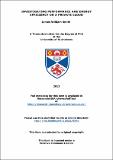Files in this item
Investigating performance and energy efficiency on a private cloud
Item metadata
| dc.contributor.advisor | Sommerville, Ian | |
| dc.contributor.author | Smith, James William | |
| dc.coverage.spatial | v, 202 | en_US |
| dc.date.accessioned | 2015-04-22T15:26:05Z | |
| dc.date.available | 2015-04-22T15:26:05Z | |
| dc.date.issued | 2014-06-25 | |
| dc.identifier | uk.bl.ethos.644808 | |
| dc.identifier.uri | https://hdl.handle.net/10023/6540 | |
| dc.description.abstract | Organizations are turning to private clouds due to concerns about security, privacy and administrative control. They are attracted by the flexibility and other advantages of cloud computing but are wary of breaking decades-old institutional practices and procedures. Private Clouds can help to alleviate these concerns by retaining security policies, in-organization ownership and providing increased accountability when compared with public services. This work investigates how it may be possible to develop an energy-aware private cloud system able to adapt workload allocation strategies so that overall energy consumption is reduced without loss of performance or dependability. Current literature focuses on consolidation as a method for improving the energy-efficiency of cloud systems, but if consolidation is undesirable due to the performance penalties, dependability or latency then another approach is required. Given a private cloud in which the machines are constant, with no machines being powered down in response to changing workloads, and a set of virtual machines to run, each with different characteristics and profiles, it is possible to mix the virtual machine placement to reduce energy consumption or improve performance of the VMs. Through a series of experiments this work demonstrates that workload mixes can have an effect on energy consumption and the performance of applications running inside virtual machines. These experiments took the form of measuring the performance and energy usage of applications running inside virtual machines. The arrangement of these virtual machines on their hosts was varied to determine the effect of different workload mixes. The insights from these experiments have been used to create a proof-of- concept custom VM Allocator system for the OpenStack private cloud computing platform. Using CloudMonitor, a lightweight monitoring application to gather data on system performance and energy consumption, the implementation uses a holistic view of the private cloud state to inform workload placement decisions. | en_US |
| dc.language.iso | en | en_US |
| dc.publisher | University of St Andrews | |
| dc.rights | Creative Commons Attribution 4.0 International | |
| dc.rights.uri | http://creativecommons.org/licenses/by/4.0/ | |
| dc.subject | Cloud computing | en_US |
| dc.subject | Energy efficiency | en_US |
| dc.subject | Distributed systems | en_US |
| dc.subject | Openstack | en_US |
| dc.subject | Virtualization | en_US |
| dc.subject | Scheduling | en_US |
| dc.subject.lcc | QA76.585S6 | |
| dc.subject.lcsh | Cloud computing | en_US |
| dc.subject.lcsh | Computer networks--Energy conservation | en_US |
| dc.subject.lcsh | Information technology--Energy consumption | en_US |
| dc.title | Investigating performance and energy efficiency on a private cloud | en_US |
| dc.type | Thesis | en_US |
| dc.type.qualificationlevel | Doctoral | en_US |
| dc.type.qualificationname | PhD Doctor of Philosophy | en_US |
| dc.publisher.institution | The University of St Andrews | en_US |
This item appears in the following Collection(s)
Except where otherwise noted within the work, this item's licence for re-use is described as Creative Commons Attribution 4.0 International
Items in the St Andrews Research Repository are protected by copyright, with all rights reserved, unless otherwise indicated.


